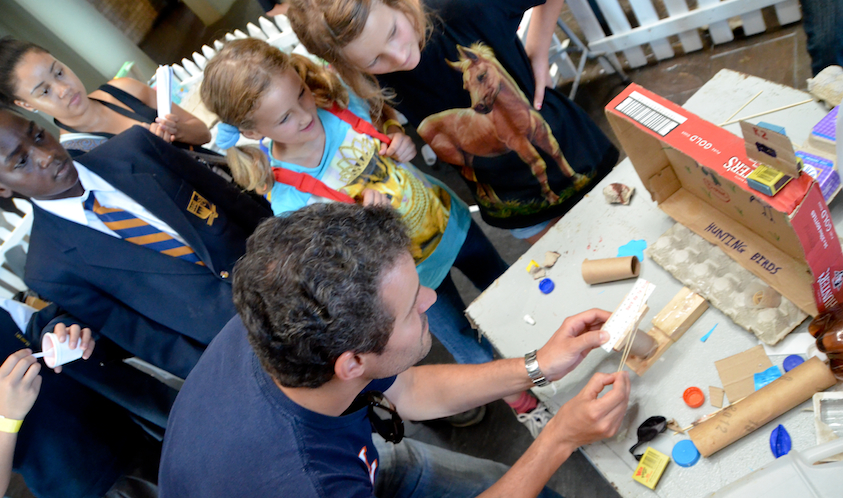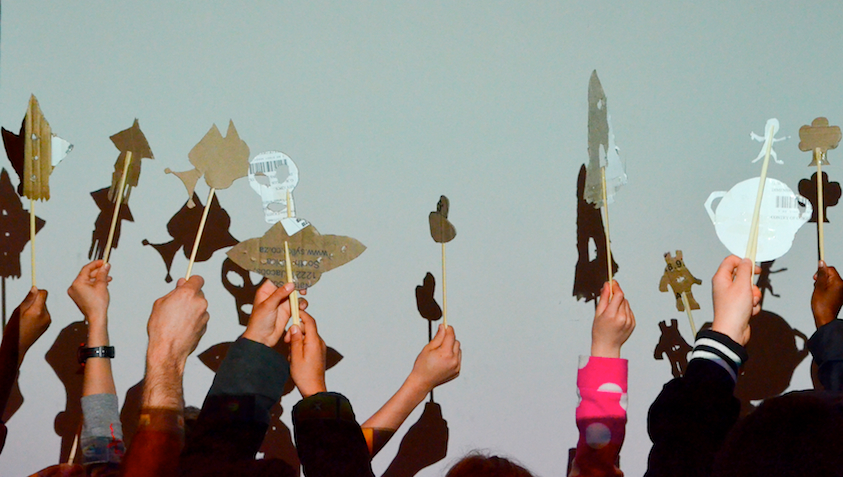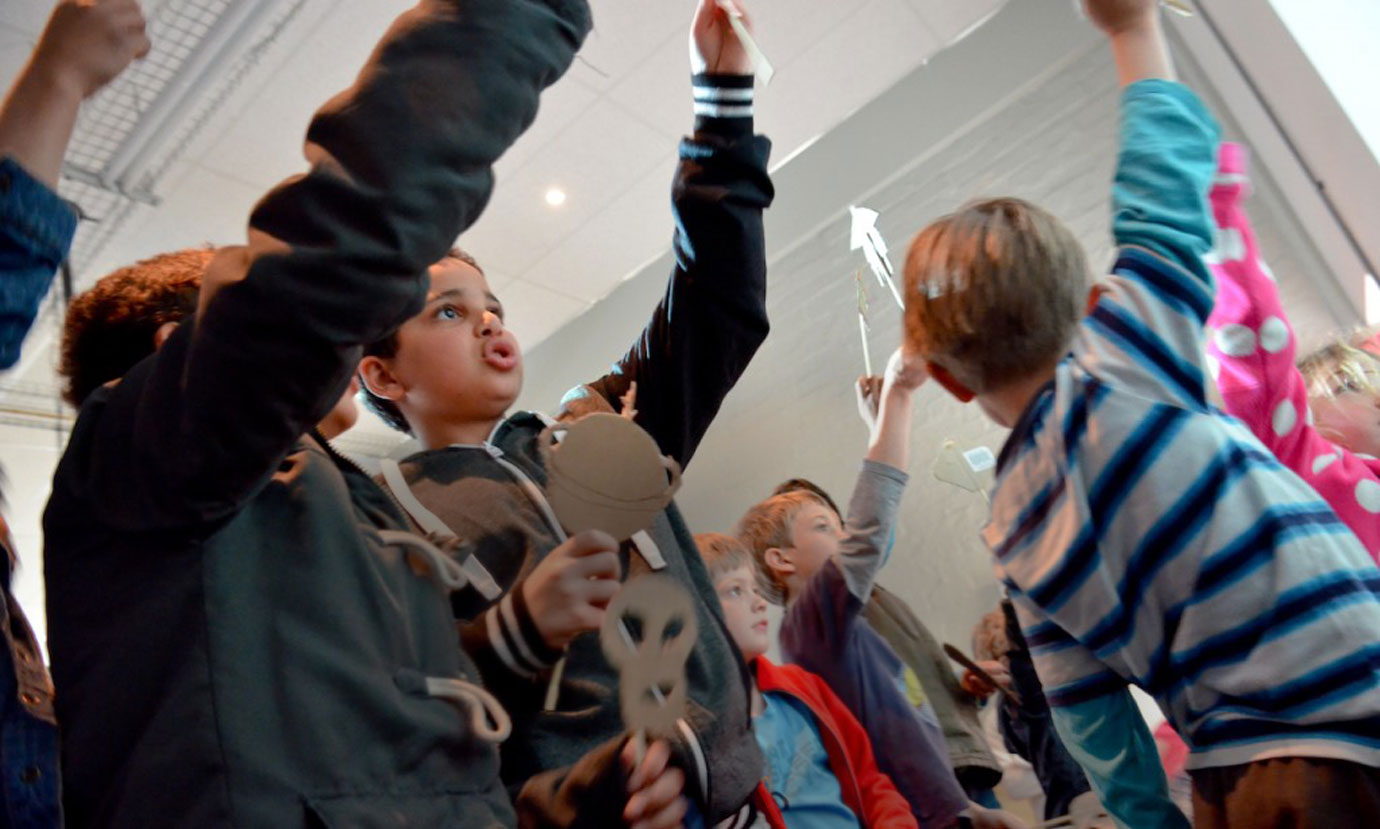Standing in a Cape Town auditorium filled with hundreds of kids, Steve Sherman asks his audience how scientists could possibly know that the Megalodon—the prehistoric 60-foot long, 100-ton ancestor to the Great White shark—once swam the seas. The kids pause and then a few shout, “Fossils!”
“Exactly,” Sherman says as he pulls out his trusty Megalodon tooth, which is about eight million years old and over half a foot long. The kids are transfixed by its size, and Sherman knows he’s captured their attention.
This is when he dives into math.
First, he introduces ratios and proportions. “We talk about how we can determine the size of a shark when we make a comparison to a Great White tooth,” he says, describing his method. “We talk about the triangle shape of the tooth and the fact that it still has serrated edges so when it presses down, it maximizes slicing. Then we’ll talk about how big a million is.”
“We talk about things they find fascinating, and they don’t realize we’re actually discussing a little bit of mathematics,” Sherman says.
For nearly two decades, Steve Sherman has been leading Living Maths, an educational organization based in Cape Town that uses creativity and hands-on learning to show kids how exciting and fun math and science can be. Living Maths works with about 4,500 learners per week either in classroom settings or through online education.
A few years ago, Sherman says, he challenged himself to teach in over 100 international classrooms through Google Hangouts and Skype. He not only wanted to see if international students would enjoy Living Maths’ curriculum, but to also “spread the joy of numbers and education.”
He achieved his goal in less than five months and says he hasn’t stopped since. Over the last few years, he has taught kids in India, Honduras, Israel, Trinidad and Tobago, Malaysia, and many other countries.
Meanwhile, in Sherman’s home country of South Africa, Living Maths has a presence in 40 Cape Town schools and runs an outreach program that improves learning in poverty-stricken areas across the country.
Education in South Africa
The kind of supplementary math and science education Living Maths provides is sorely needed in many South African communities. Only 58.6 percent of South African children in sixth grade are functionally numerate, according to a study by the University of Stellenbosch, and the vast majority of children who are far behind in mathematics are children of color.
Although apartheid, a system of racial segregation, was abolished 20 years ago, race is still a powerful predictor of education quality and economic status.
The recent study Poverty Traps and Social Exclusion Among Children in South Africa 2014, commissioned and funded by UNICEF South Africa and the South African Human Rights Commission, states that “Despite remarkable progress in reducing the effect of deprivation for many of its poorer citizens, the country is still plagued by poor education quality, high levels of unemployment, particularly among its youth, and widespread dissatisfaction with the pace and quality of basic service delivery.”
“When it comes to South Africa,” Sherman says, “we’ve got communities that are so poor that if you actually go to their homes, you will find a 10 foot by 10 foot shack made out of corrugated iron and a family of four living there. They don’t have a toilet or a kitchen or bathroom inside their shack.”
Living Maths’ programs reach several hundred kids each week. In poor areas such as Phillipi and Lower Crossroads in Cape Town, the organization provides children with excellent teachers, revises the students’ current course work, and prepares them for their exams. Their main focus in these communities is to consolidate the basics and empower kids to cope with everyday school math.

Students who are part of Living Maths’ outreach programs during their field trip to the Cape Town Science Centre. The kids are doing hands-on math and science activities that are curriculum-based. (Photo c/o Steve Sherman)
And the organization’s outreach efforts have proven successful.
One of the projects, Prudential Math, has resulted in major improvements in 12th-grade math scores. In 2006, only 16 percent of 12th graders passed math, but after Living Maths’ intervention in 2007, over 50 percent did. In 2011, the results climbed to an 88 percent pass rate.
Sherman attributes the success of Living Maths’ programs to how he and his staff approach teaching. “Math,” he says, “is not just a bunch of numbers and sums. It is a way of thinking, and it’s all about problem solving.”
He is also a strong believer in the creative approach to teaching: “If I give you skills like mathematics, I must also give you the ability to use those mathematics in a creative way so it is relevant five years from now.”
“Unfortunately,” Sherman adds, “a lot of teachers think you show kids a method, teach them facts and terminology, and that makes them equipped to do math. It is actually the complete opposite. When they get a test, and a teacher changes the wording slightly, they don’t understand what the teacher is asking.”
To help them understand math concepts, Sherman says, you have to make it fun.
Creativity + Math
Sherman’s hands-on and creative approach positively affects thousands of kids at different schools across Cape Town each week. One of his favorite ways to get kids hooked on math and science is by introducing them to different themes. During a recent school term, for example, the theme was Criminal Scene Investigation (CSI). Students used science and math to solve mysteries. They studied the logic of crime scenes and drew illustrations of criminals using photos and identikits.
Another project was all about espionage, with students examining different codes and learning how to transmit messages. “We put the kids into various scenarios, and they had to tell us how they would escape or accomplish a tough mission,” Sherman says.
There’s no shortage of ways Sherman has tried to make math and science fun for these kids. His methods have led to Living Maths’ annual Math Olympiad competition; the organization’s live Google Hangouts with retired NASA astronauts and accomplished scientists; brain teasers featuring Sherman’s math characters “King Height” and “Sir Cumference”; a weather balloon launch into space; and participation in thefroot Global Cardboard Challenge.

A parent plays the Hunting Birds game created at the Science Festival by a group of students during the Global Cardboard Challenge. (Photo c/o Steve Sherman)
Sherman learned about the Challenge in the same way many others have: through the film Caine’s Arcade. As an educator, he was blown away by Caine’s ability to use math and science to create his arcade. “I was watching him use the calculator and use the square root to determine if the Fun Pass was legitimate or not. He wrote down the square root of a number. He showed the square root of two on the ticket, which showed that it was an authentic ticket. I thought this was very innovative,” Sherman says. [Watch the film here to see this moment.]
The kids involved in Living Maths were first introduced to the Global Cardboard Challenge in 2012. And it got such a positive response that Sherman brought it back in 2013. Hundreds of kids took part in the Global Cardboard Challenge at the Cape Town Science Centre on October 5, 2013.
During the Challenge, kids of many different backgrounds worked together to construct inspired pinball machines, mazes, and a very cool target toss out of cardboard, egg crates, construction paper, plastic bottles, bottle caps, and balloons. Kids even made shadow puppet theaters.

Kids project their space-themed cardboard creations on a screen in the puppet theater. (Photo c/o Steve Sherman)
First, the kids made silhouettes from pieces of cardboard, but they weren’t tasked with decorating them or making them look pretty. “It’s not what it looks like on the outside, it’s the way the light reflects off it and makes the shadow on the wall that counts,” Sherman says. “Some of the kids realized if they moved it toward or away from the projector, the size changed, and if it they changed the angle, it changed the look and feel of the device.”
The activities took place during World Space Week, so the kids made puppets of rockets and space ships and created a journey into outer space inside the dimly lit theater. They took initiative and “made animated movies, and created aliens that jumped on top of the rocket ships,” Sherman says.
Through the Cardboard Challenge, Sherman says, he hoped to “give everybody the opportunity to feel the excitement of learning.”
And when kids walk away with their cardboard creations, they remember the activity but don’t even realize the number of skills they’ve gained by working in teams, learning how to listen to each other, measuring and building, and bringing their ideas to life.
“Those things,” Sherman says, “are far more important than learning a mathematical formula.”
Join Our Global Imagination Hangout
Join us for a Hangout-On-Air with Steve Sherman of Cape Town and other ‘math magicians’ and creative educators from around the world. We’ll chat about how to use creativity, humor, global collaboration and technology to make kids fall in love with math and learning. The G+ Hangout will be broadcast live on Thursday, September 4, 12 pm PST / 3 pm EST / 9 pm South Africa Standard Time. Join us (and share your questions via the Q&A section).
This story was written by Jenny Inglee, the Imagination Foundation’s Imagination Curator and The Storybook Editor. The first collection of stories in The Storybook focus on the work of inspiring individuals, schools, and organizations that participated in the 2013 Global Cardboard Challenge.
[primary_link_alt text=”Sign me up for The Storybook” href=”https://eepurl.com/MDElb” style=”margin-left: 0;”]


Recent Comments